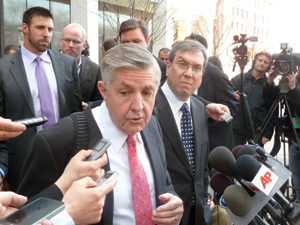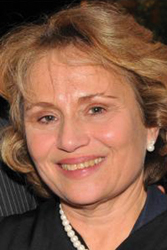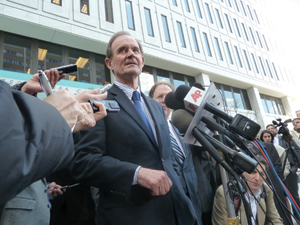U.S. District Judge Susan Richard Nelson looked tired.
Her NFL lockout hearing was nearing the end of four hours and 17 minutes of grueling, complex legal arguments, with more than half of that in robust give-and-take with owners’ lawyer David Boies. Nelson allowed the attorneys for the current NFL players and retirees their full say, too.
With the clock in her St. Paul courtroom ticking toward 3:15 p.m., the judge informed both sides that she would need “a couple of weeks” to come to a fair ruling on whether to issue a preliminary injunction, sought by the players in this Tom Brady v. NFL case. The players want her to lift the lockout imposed by the owners last month.
Then, Nelson moved up in her chair. The U.S. flag stood behind her. She looked down from the elevated judge’s bench to the score of lawyers, the dozens of journalists, and a handful of current and former players before her. Nelson pointedly urged both sides to “come back to the table. Not to the union table, not to the players’ table, but to the federal court table. … This is really a matter that should be resolved.”
Known for her mediation and settlement skills
 |
JAY WEINER (2)
David Boies (top) argued for the owners, Jim Quinn (with Jeffrey Kessler) for the players. |
as a trial lawyer in Minneapolis and then as a federal magistrate for 10 years before being elevated to the district court four months ago, Nelson offered to aid and “facilitate suggestions” for resolution, a message to get it done before she weighed in with her injunction decision.
Her suggestion to use the auspices of her court seemed to be a mini-victory for the players. Theirs is a litigation strategy to be played out in court. Having “disclaimed” their affiliation with a union, they believe the dispute with the owners is an antitrust case for the courts. Having a federal judge oversee the outcome of this current struggle with the owners would begin to look a lot like how the league’s labor life was resolved by Judge David Doty in 1993, with a court-supervised settlement.
For the players, returning to St. Paul soon to use Nelson’s chambers as a venue for resolving the matter seemed, on the face of it, like a good idea.
“It’s something we’ll consider,” players’ lawyer Jim Quinn told reporters outside the courthouse afterward. “We heard what the judge said, and she said it forcefully.”
For the owners, putting their future in Nelson’s hands wasn’t as appealing. “We believe these kind of matters ought to be settled at the collective-bargaining table, not in federal court,” said Boies, who gently sparred with Nelson through three separate sessions in which she allowed him great latitude to attempt to convince her that the league’s lockout was legal.
Notes from the lockout
hearing in St. Paul • Walking into the courtroom 40 minutes before the gavel sounded, NFLPA Executive Director DeMaurice Smith saw the pew-like benches in the gallery and told the U.S. marshal, “I want to be on the groom’s side.”
| 
| Nelson |
• You know the attorneys are high-powered when this happens: Judge
Susan Richard Nelson’s clerk and courtroom deputy,
Joan Flood, informed those in the courtroom to turn off their cell phones; that if they left during the hearing, they wouldn’t be allowed back until there was a break; and, “Those seeking autographs from either the lawyers or the players … you need to do that outside the courthouse.”
• One of the first labor cases in the NFL dates to 1975, when former players of the World Football League claimed NFL owners colluded to boycott the hiring of players from the defunct league. The judge in that case was Edward J. Devitt. He issued an injunction prohibiting NFL owners from barring WFL players from signing with NFL teams. Historic irony: Wednesday’s hearing was in the Devitt Courtroom, named for him after his death in 1992. At one point during the day, Nelson, who gave the lawyers lots of time to make their points, said: “You know, we’re in Judge Devitt’s courtroom. Judge Devitt would always say, ‘Have I heard you out?’”
On Wednesday, Nelson heard all the lawyers out.
— Jay Weiner
In the owners’ view, Boies said, bargaining should be overseen by the Federal Mediation and Conciliation Service, adding to the reporters afterward: “We don’t need a settlement of this [antitrust] lawsuit. We need a collective-bargaining agreement.”
Earlier in the day, Nelson, fully engaged and asking incisive questions to all the lawyers, repeatedly hinted that she was buying the players’ arguments and not the owners’. The players’ basic point: She has the jurisdiction to lift the lockout and, under some undefined system, put the players back to work. The lockout, the players argue, trips the 32 owners into an antitrust violation because the players are no longer in a union. It also inflicts “irreparable harm” on the players, and Nelson acknowledged the players had a “strong” case on that score.
Boies disagreed and repeatedly argued that the lockout is a matter for the National Labor Relations Board, not Nelson. He also argued that a 1932 federal law known as the Norris-LaGuardia Act bars her from issuing an injunction against the lockout. But Nelson, examining the act in detail, expressed “having trouble” with that Boies assertion; Norris-LaGuardia was enacted to protect unions against overzealous federal judges.
“Isn’t there some bit of irony,” she stated, that the Norris-LaGuardia Act “intended to halt strike-breaking judges should now be used by a wealthy multiemployer unit seeking to break a players union?”
Retired NFL players, led by former Minnesota Vikings’ great Carl Eller, also sought to lift the injunction and begin an antirust case against the owners, claiming their pensions and health benefits were at stake. Without objection from the current or former players or the league, Nelson consolidated the Brady and Eller cases.
As for any Nelson decision, it’s sure to be appealed by the losing side. Using a football analogy, Boies said: “I think this is the first quarter. Hopefully, we can divert the game back to the playing field.”
But, not, it seems, any time soon.
Jay Weiner is a writer in Minnesota.






